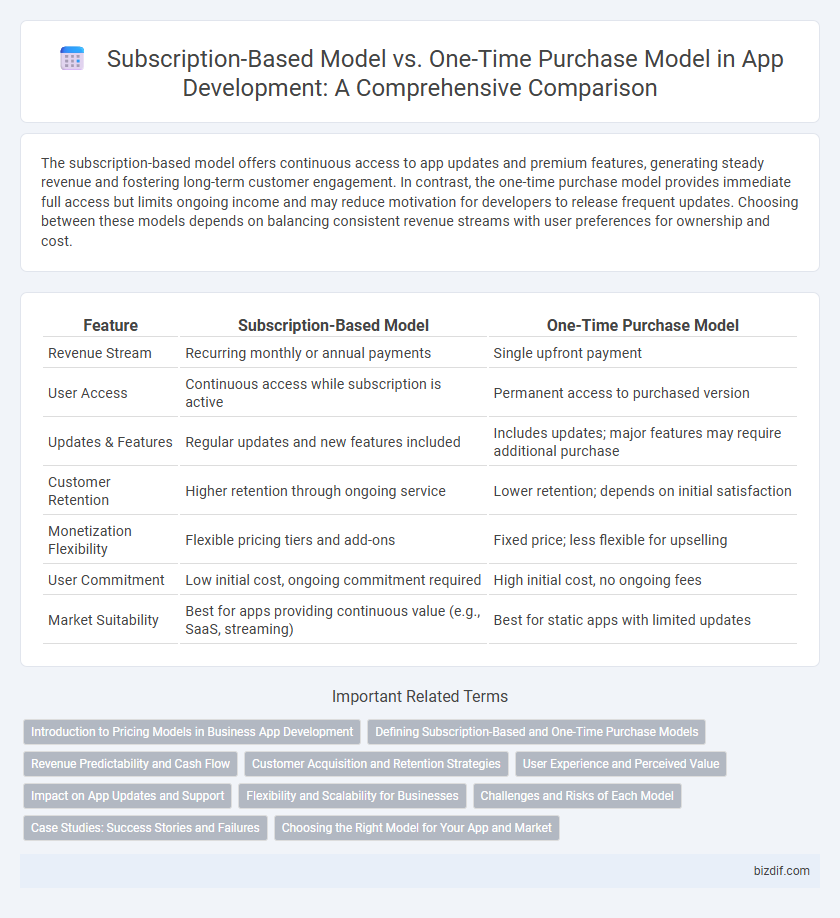The subscription-based model offers continuous access to app updates and premium features, generating steady revenue and fostering long-term customer engagement. In contrast, the one-time purchase model provides immediate full access but limits ongoing income and may reduce motivation for developers to release frequent updates. Choosing between these models depends on balancing consistent revenue streams with user preferences for ownership and cost.
Table of Comparison
| Feature | Subscription-Based Model | One-Time Purchase Model |
|---|---|---|
| Revenue Stream | Recurring monthly or annual payments | Single upfront payment |
| User Access | Continuous access while subscription is active | Permanent access to purchased version |
| Updates & Features | Regular updates and new features included | Includes updates; major features may require additional purchase |
| Customer Retention | Higher retention through ongoing service | Lower retention; depends on initial satisfaction |
| Monetization Flexibility | Flexible pricing tiers and add-ons | Fixed price; less flexible for upselling |
| User Commitment | Low initial cost, ongoing commitment required | High initial cost, no ongoing fees |
| Market Suitability | Best for apps providing continuous value (e.g., SaaS, streaming) | Best for static apps with limited updates |
Introduction to Pricing Models in Business App Development
Subscription-based models in business app development generate recurring revenue by charging users periodically, facilitating continuous updates and customer engagement. One-time purchase models provide immediate income from a single upfront payment, appealing to users who prefer owning the app without ongoing fees. Choosing the right pricing strategy depends on factors like target audience, app functionality, and long-term monetization goals.
Defining Subscription-Based and One-Time Purchase Models
The subscription-based model involves users paying recurring fees, typically monthly or annually, to access app features or content, enabling continuous updates and customer engagement. In contrast, the one-time purchase model requires a single upfront payment granting permanent access to the app without additional charges. These models impact revenue streams, user retention metrics, and development strategies significantly.
Revenue Predictability and Cash Flow
Subscription-based models offer consistent, recurring revenue streams that enhance revenue predictability and stabilize cash flow for app developers. One-time purchase models generate immediate cash influx but lead to unpredictable revenue fluctuations, complicating long-term financial planning. App developers prioritizing steady cash flow and scalable growth typically favor subscription-based monetization strategies.
Customer Acquisition and Retention Strategies
Subscription-based models enhance customer acquisition by offering lower upfront costs and continuous value updates, which encourage long-term engagement and predictable revenue streams. One-time purchase models attract users seeking immediate ownership without ongoing payments but often require frequent new releases or marketing efforts to maintain retention. Effective retention strategies in subscription models include personalized content, regular feature updates, and loyalty rewards, while one-time purchase models benefit from community building and timely customer support.
User Experience and Perceived Value
Subscription-based models enhance user experience by offering continuous updates, personalized features, and ongoing customer support, which increase perceived value through sustained engagement and evolving content. One-time purchase models provide immediate full access without recurring fees, appealing to users who prefer simplicity and ownership, but may limit long-term feature expansion and updates. The choice between models impacts user retention and satisfaction, with subscription services often driving higher lifetime value through consistent value delivery.
Impact on App Updates and Support
Subscription-based models ensure continuous revenue streams, enabling developers to provide regular app updates and extended customer support. One-time purchase models often result in limited updates and diminished support over time due to lack of ongoing funding. Consistent income from subscriptions directly correlates with higher user satisfaction through frequent feature enhancements and timely bug fixes.
Flexibility and Scalability for Businesses
Subscription-based models offer businesses greater flexibility and scalability by enabling continuous revenue flow and easy adaptation to user demand through tiered service plans. One-time purchase models provide fixed revenue but limit scalability due to static pricing and lack of ongoing customer engagement opportunities. Emphasizing subscription options helps app developers support dynamic business growth and evolving user needs more effectively.
Challenges and Risks of Each Model
Subscription-based models face challenges such as user retention difficulties and continuous value delivery to justify recurring fees, leading to unpredictable revenue streams and increased customer churn risk. One-time purchase models risk limited long-term engagement and revenue, making it challenging to fund ongoing updates and support without additional monetization strategies. Both models require careful balancing of customer satisfaction, pricing strategies, and update frequency to mitigate financial instability and market competition risks.
Case Studies: Success Stories and Failures
TurboTax's subscription-based model generates continuous revenue and user engagement through regular updates and personalized tax advice, leading to sustained growth. In contrast, Adobe's shift from one-time purchases to subscriptions faced initial resistance but ultimately increased recurring revenue and customer retention via cloud-based services. Conversely, Microsoft's failed attempt with Windows 8's one-time purchase model highlighted limitations in flexibility and updating, emphasizing the success of subscription models in maintaining user loyalty and steady income.
Choosing the Right Model for Your App and Market
Choosing the right monetization strategy depends on understanding your app's target audience and market demand. Subscription-based models offer recurring revenue and higher customer lifetime value, ideal for apps delivering ongoing content or services. One-time purchase models suit apps with permanent features and appeal to users preferring a single payment without future charges.
Subscription-Based Model vs One-Time Purchase Model Infographic

 bizdif.com
bizdif.com